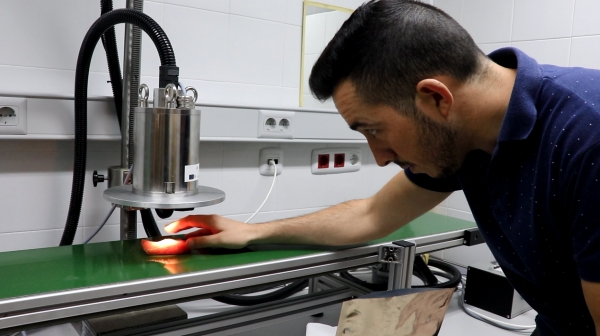When a person buys an Iberian pork product, he has to takes his chances and hope that it is of the highest quality. He can examine its colour, texture and fat to improve his chances, but sometimes he is unlucky, and the product purchased is of lower quality than what its label indicates. The case is that quality analyses of most of these products, despite their high prices, are carried out by batch, not individually. Therefore, there may be cuts of different quality distributed in the same batch and sold at the same price.
The AGR-128 research group in the Department of Animal Production at the University of Córdoba seems to have found the key to solving this problem. With years of experience in the development of methodologies for the analysis of meat products, it has developed an application to analyse the quality of Iberian pork loin in a faster, more precise, and, more importantly, online, individualized and non-destructive way.
They have done so based on the use of Near Infrared Spectroscopy (NIRS), on which the group has carried out intense research work. NIRS technology is widely used in the agri-food industry to perform this type of quality analysis, and some of its equipment does not require contact with the sample. "This technology manages to generate, in real time, a spectrum that is unique for each type of product and that yields information on all parameters; in this case, the level of fat, protein and humidity, for which previously predicted models have been developed", explains Juan Manuel Cáceres, one of the researchers with the group, who is doing his doctoral thesis in this area. In the laboratory, they have an industrial NIRS technology system that can be easily integrated into a factory's processing line.
Until now, traditional methods have involved the destruction of the meat sample, mincing it to later analyse it in the laboratory and determine its composition. This process, very slow and destructive, is not able to analyse the pieces separately. Another method is to perform field inspections. Professionals analyse the conditions under which the animals are raised, and rate each batch based on their findings. This does not yield entirely objective results, however, and the individual characteristics of each animal are not taken into account.
"The main purpose of the study was to test the effectiveness of NIRS technology to individually analyse intact pieces of Iberian loin," says Professor Dolores Pérez Marín, one of the researchers who led the study. "Although the information we obtain is more accurate when analysing the chopped product, the results when analysing the intact piece are sufficient for the industry to make real-time decisions about product quality," he explains. In this way, it is possible to analyse the quality of each of the pieces that go on the market, and, therefore, individual labelling. The person who purchases the product will know exactly what they are buying.
The research group continues to work in this direction to improve calibration models to perform these quality analyses on intact parts. "The next steps will be to see what effect freezing has on product quality, and to apply this technology to the analysis of already-cured products," indicated Professor Emiliano De Pedro, another of the group's researchers. The main objective, according to the researcher, is to work to provide the industry with concrete and effective solutions.
J.M. Cáceres Nevado, A. Garrido Varo, E. De Pedro Sanz, D.C. Pérez Marín. Fourier transform near-infrared spectroscopy coupled to a long fibre optic head for the quality control of IBERIAN pork loins: Intact versus minced. Meat Science. DOI: 10.1016/j.meatsci.2019.03.008


